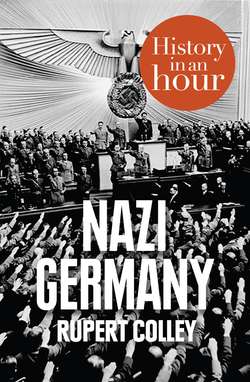Читать книгу Nazi Germany: History in an Hour - Rupert Colley - Страница 8
ОглавлениеDAP: Member 555
The Kapp Putsch, as it became known, may have failed but it illustrated the feeling of anger among the extreme right in Germany. Among the many small political parties was the German Workers’ Party or, to use its German abbreviation, DAP, set up in 1919 by 35-year-old Munich locksmith, Anton Drexler. The DAP, a far-right party that aimed at appealing to the workers, consisted of only about fifty members but, to give the impression of greater numbers, began their membership cards at number five hundred.
It was to a meeting of this party that in September 1919 Adolf Hitler, at this stage being groomed by the army as a political instructor, was sent to observe and speak. The beer hall meeting consisted of only about twenty attendees but Hitler’s speech so impressed Drexler that he was invited to join the party. With membership number 555, although he later claimed in Mein Kampf that he was the seventh member, he signed his name as ‘Hittler’.
NSDAP: Nationalism and Socialism under One Roof
Hitler’s oratory and leadership skills were evident and he soon took over from Drexler as the DAP’s leader. On 24 February 1920, still maintaining its peculiar mix of right extremism and socialist ideals, the party lengthened its name to the Nationalist Socialist German Workers’ Party, or NSDAP. Now boasting 3,000 members, the Nazi Party was born. Two months later Hitler resigned from the army to concentrate full time on expanding his party.
Corporal Hitler
Born in 1889 in Austria, Hitler spent much of his youth in Vienna, living in cheap accommodation, frequenting coffee houses and trying to sell his paintings. Art was his passion and his failure to secure a place at art school plunged him into depression. Resentment of the Jew was rife in the city and Hitler absorbed this anti-Semitism and, like many of his contemporaries, believed the Jew to be set apart from ‘the rest of humanity’.
At the outbreak of the First World War Hitler was in Munich and, having managed to avoid conscription into the Austrian army, signed up to a Bavarian regiment within the German army. He served as a messenger and did so with distinction throughout the war. Having no aspirations for promotion, he finished the war as a corporal having twice been awarded the Iron Cross and twice wounded – the second time in October 1918 when he was temporarily blinded by mustard gas.
Adolf Hitler (right) during the First World War
It was during his recuperation that the armistice was signed, leaving Hitler and many other Germans embittered. Germany had won the war in the east, and following the ‘Spring Offensive’ of 1918, looked well placed to win it in the west. But a strike of German munitions workers towards the end of the war, believed to have been organized by Jews, disrupted the supply of arms and the front-line soldier suffered as a consequence. The government had accepted defeat and it was they, not the soldier, who had lost Germany the war. The signing seven months later of the Treaty of Versailles confirmed this sense of betrayal, the feeling that the German people had been ‘stabbed in the back’.
As the new leader of the fledging Nazi Party, Hitler met Hermann Göring and Rudolph Hess, two men who would serve him well over the next twenty years, and Ernst Röhm (pictured with Hitler), a tough ex-soldier and former member of the Freikorps, who went on to form the Nazi Storm Troopers (or SA).
Hitler and Röhm, 1933
Bundesarchiv, Bild 146-1982-159-21A / Unknown / CC-BY-SA
